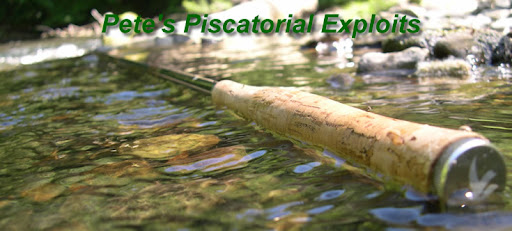Another of Steve James' opportunities arose in that we joined Louis Noble's Advanced School of Game Angling (ASGA) for a day on the Dee at Maelor. Steve secured four rods with Louis in what turned out to be a most informative trip.
The session covered quite a broad spectrum of methods from Czech Nymphing through Duo and dry fly to Spey casting with wets.
From L-R: John, Yours Truely, Keith, Simon and Louis
Our initial kick sampling proved a little disappointing in its yield. A small selection of stonefly nymphs with one or two 3 tailed upwings nymphs, cassed caddis and caddis pupa were analysed. It never ceases to amaze me how bright some pupating caddis are; 'eat me' in neon green. Naturally [pun intended] the kick sampling evolved into imitations and setup for Czech Nymphing with Louis demonstrating his tactical wading approach.
L-R: Steve, YT and Louis pre kick sample
A move to setups and how to fish the duo was followed by lunch. During which Simon demonstrated his Tenkara setup for nymphing. John, as open minded as ever and always one to attract fish, willingly took the rod from Simon and into the river he went. After half a dozen or so casts, he is a magnet, an 8oz Grayling obliged (another coup for Tenkara Promotions Ltd.). It was quite funny watching him wrestle the fish with 12' of T and 16' of leader/tippet. If you are experiencing T for the first time without instruction this can be quite tricky.
CZN demo
Post lunch and Louis' spider fishing session. His own goto spider setup consists of four spider patters on an 11.5' cast. The make up of the leader has become quite critical to enable good tangle free turnover and is effectively a weight forward leader where the first third tapers up in diameter before tapering down the point. The secret recipe is in my pocket;). The cast is fished across and down which, although some of us may question, Louis assures catches a very large volume of good fish. If the rod is held high and tracked with the current a series of dead drifts across the river can be acheived. When one drift has drifted out do not be afraid to raise the rod up again, even if the team pulls from the water and then drift down again. Keep this until on the dangle below. The leader setup alone does not prevent tangles, but a double spey cast is absolutely necessary especially with the Dee's prevailing downwinder. So when on the dangle the spey cast (which just changes direction to across again) keeps the cast straight and tangle free.
The setup is best coupled with a double taper line matching the weight of a minimum 10' rod. A 3 or 4 weight. This is incredibly simple and pleasurable one handed fishing.
YT completing the cast. Error here is in not driving the tip down low enough to prevent downstream bows and extra line mending
Another subtlty that becomes apparent is to hold the rod butt low and tip high when getting towards dangling out, this does give that extra few feet of drag free drift.
A good example of holding rod butt low. You can also see the shallow streamy water that best suits this method
From the diagram above, it can be seen how with several drag free drifts then a mend upstream the amount of water that can be covered. After dangling out, take a step downstream
This method of wet fly fishing covers a lot of water and is so simple. The most complex part is leader make up, but this should be done at home and wound onto a cast carrier.
Top tip from Louis regarding tangle free droppers was to essentially paternoster the droppers. Create the dropper length by creating a 3/4" to 1" loop at the end of the dropper and then passing the dropper loop over and above leader knot and back through itself. The result is a sliding dropper that stops on a knot in the leader make up. The loop in the dropper holds the dropper away from the leader. I know a two turn water knot is favoured by many, but although these may not tangle around the leader they do twist around the leader. Give this some consideration.






